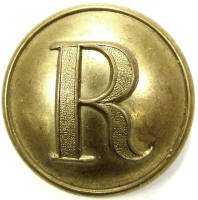
A virtual examination of artifacts of the American Civil War
 |
Ridgeway Civil War Research Center, A virtual examination of artifacts of the American Civil War |
| Civil War Artillery | |
| by Harry Ridgeway |
| Rifled artillery projectile, Whitworth design Research Center: Artillery5900-Whitworth Details click: http://relicman.com/artillery/Artillery5900-Whitworth.html. |
| Rifled artillery projectile, Whitworth design, English manufacture, solid bolt, hexagonal spiral rifling with no sabot, Whitworth 12 pounder rifle, 2.75 in. Projectile was English manufactured following the invention of Sir Joseph Whitworth. The weapon employed a breechloading gun with hexagonal rifled twist that was more extreme than other conventional rifling systems. The result was that projectiles fired from a Whitworth rifle would achive greater spiral and greater range, however the shells had to be long and narrow and consequently could not carry a meaningful explosive charge in smaller calibers. This weapon system never was accepted by the English government and so all production was exported, most of it to the Civil War in America. However the cannons were difficult to manufacture and the shells and guns required more prescion machining than was typically practiced at the time, so few actually made it into the field, most were sold as surplus stocks after the war through Bannerman. Projectile measures: diameter 2.73in., length 9.5in., weight 12 lbs. Research Center: Artillery5911-Whitworth, Ref: Dickey & George, Field Artillery (1993 Edition), pg. 329. Details click: http://relicman.com/artillery/Artillery5911-Whitworth.html. |
| Rifled artillery projectile, Whitworth design, English manufacture, bursting shell, hexagonal spiral rifling with no sabot, detachable nose, fuze type not determined, Whitworth 12 pounder rifle, 2.75 in. Projectile was English manufactured following the invention of Sir Joseph Whitworth. The weapon employed a breechloading gun with hexagonal rifled twist that was more extreme than other conventional rifling systems. The result was that projectiles fired from a Whitworth rifle would achive greater spiral and greater range, however the shells had to be long and narrow and consequently could not carry a meaningful explosive charge in smaller calibers. This model did have a bursting chamber and a detachable nose, with a fuze. However all known examples came from surplus stocks with the fuzes cut out, so we do not know what type of fuze was actually employed. This weapon system never was accepted by the English government and so all production was exported, most of it to the Civil War in America. However the cannons were difficult to manufacture and the shells and guns required more prescion machining than was typically practiced at the time, so few actually made it into the field, most were sold as surplus stocks after the war through Bannerman. Projectile measures: diameter 2.9in., length 9.0in. (excluding fuze), weight 11.7lbs. Research Center: Artillery5915-Whitworth, Ref: Dickey & George, Field Artillery (1993 Edition), pg. 329. Details click: http://relicman.com/artillery/Artillery5915-Whitworth.html. |
| Rifled artillery projectile, Whitworth design, English manufacture, bursting shell, hexagonal spiral rifling with no sabot, fuze type not determined, Whitworth rifle, 3.75 in. Projectile was English manufactured following the invention of Sir Joseph Whitworth. The weapon employed a breechloading gun with hexagonal rifled twist that was more extreme than other conventional rifling systems. The result was that projectiles fired from a Whitworth rifle would achive greater spiral and greater range, however the shells had to be long and narrow and consequently could not carry a meaningful explosive charge in smaller calibers. This model did have a bursting chamber and a detachable nose, with a fuze. However all known examples came from surplus stocks with the fuzes cut out, so we do not know what type of fuze was actually employed. This weapon system never was accepted by the English government and so all production was exported, most of it to the Civil War in America. However the cannons were difficult to manufacture and the shells and guns required more prescion machining than was typically practiced at the time, so few actually made it into the field, This caliber was known to have been in use at Sabine Pass Texas. Projectile measures: diameter of flat surfaces, 3.7in. length 14.75in. weight 29 lbs. Research Center: Artillery5921-Whitworth, Ref: Bell Heavy Ordnance pg. 446. Details click: http://relicman.com/artillery/Artillery5921-Whitworth.html. |
| Ridgeway Civil War Research Center, A virtual examination of artifacts of the American Civil War. Artillery Research center, artillery, click: http://relicman.com/artillery/Artillery0000-Index.html. Research center, artillery, click: http://relicman.com/artillery/Artillery0000-Index.html. |
| Civil War Relicman, Harry Ridgeway, Civil War artillery, Relicman sales catalog. Click here: http://relicman.com/artillery/RelicmanSalesArtillery1.html. Artillery for sale: http://relicman.com/artillery/RelicmanSalesArtillery1.html. |